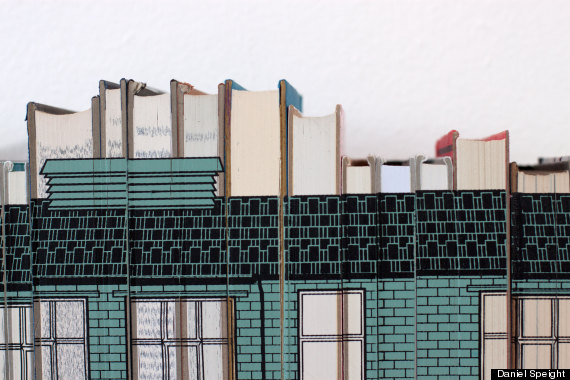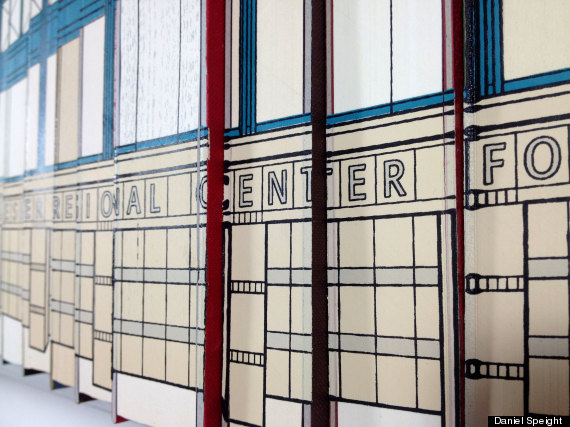A journalist called Charlene Lam hit the nail the head when she wrote that "books and cities have a lot in common: they're both full of stories" in describing my new art series, BookBlock. It was here that I realized there was something special about peoples' relationship with buildings and the books they own, and that's what defines this project.
Stumbling through the streets of Hackney in East London one night, I discovered that the undulating heights and shapes of the houses looked remarkably similar to the way my bookshelves looked at home. London has this charming quality about it where varied eras of architecture sit alongside each other - the effects of The Blitz are still noticeable today in the way modern post war housing is set against Victorian terraced houses. This urban tapestry echoed the irregularities of my bookshelves at home, with the books' lopsided relationships to each other.
It dawned on me how through the memories of living amongst these familiar buildings and the spaces I walk through daily, I have invested something of myself to this city in a similar way that a reader invests time and imagination to the text in their book. The books that surround me and fill the walls of my study I have carried with me for years. They represent a journey or something about me. Books that I had had when young and watched me grow up, some that I never got round to reading and others that I revisited again. Some just look nice. They are all charged with a personal significance - just like the streets of Hackney.
As an artist I have always needed to use pre- existing materials. Something that has its own history in which I could explore their physical qualities in printmaking - finding old bits of skirtingboard or tired furniture to print on. Working with books was a logical progression. So I crafted my own process to screen print illustrations of these buildings directly onto the fore-edges of old books which would allow them to still be seen on bookshelves.

Seeing screen printing as fundamentally transferring an image to any flat surface, I had devised a way of making a collection of books work as a canvas for me to print on whilst keeping the function of the book. The need to print on books came from drawing on the sides of telephone directories when I didn't have paper when I was very young- It just seemed like a blank space that needed filling in. I liked the way that after drawing on the side, each separate page would have a few specks of a mark but that you could build the image together page by page. There's huge potential with books as a material. I like the way that squeezing pages together almost reverts paper back into being like wood.
Last year I made a piece for LondonPrintStudio's "Reincarnation" show as part of the London Design Festival where I recreated the brutalist classic "Trellick Tower" as a Bookblock. At the opening show a man who'd lived in the infamous building just around the corner of the gallery for the past twenty years walked in from the street and came straight up to me to ask about it.
Despite never showing a previous interest in printmaking, he felt compelled to come in and look at the work up close and talk to me about his experiences in living in this social housing project that for better or worse defined an era of modernist architecture in post war London. It was the sense that I had made something that connected with another person enough for him to want to share a bit of his own life that made the work a success to me. There was another story inside Trellick's 31 existing stories.

In terms of influence, I became interested in the look of comic books a lot later in life. After my lofty art education there seemed something honest and sincere about the look of certain graphic artists who sought to capture everyday life through their own aesthetic styles. In particular, on a very visual level the work of Chris Ware remains a central influence to the way I draw and print a building.
Ware sets very simple thick and thin lines to create images that lift out of the page and striking color palates that beautifully pull objects out from their surroundings, whilst being pleasant on the eye. In my own work I also like to mix the weight of lines to bring depth and bounce to the image. This use of line also acts as a process of simplifying the detail of the building to one that is printable through screen printing techniques.

The very nature of screen printing on unequal surfaces, such as books, means you can't always get all the details in the print. But by creating stronger, simpler versions, of for example Victorian cornices or Georgian window frames, its essence can remain in its interpretation. Every art is reductive to some extent and you have to select what details are important to keep and what can be omitted without compromising too much.
Chris Ware's very recent work, "Building Stories," has a great play with perspective, where his buildings both fall back to a vanishing perspective to the street and yet still reveal their front surface as if you were looking at it head on. What he does is strictly untrue, but it looks purposeful and this is something I like to play with in my own work also - distorting perspective to capture aspects that would otherwise be hidden from view. It's taking an artistic license and using it to your own effect.
The Fun Loving Criminals said, "The View Belongs to Everyone." We don't have to own the city to have a stake in it. We're all Londoners and even if you don't own any of it, you're still creating it. That's what 'BookBlock' is about - our own connection with our surroundings.
Here are several photos of my work, and my process:
